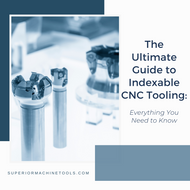The Ultimate Guide to Indexable CNC Tooling: Everything You Need to Know
Published by Kortney on Jul 6th 2023
The Ultimate Guide to Indexable CNC Tooling: Everything You Need to Know
Do you know what makes modern machining so effective? One essential component behind its success lies in indexable CNC tooling. In this guide we will review indexable tooling types, applications, benefits, and how to choose the right tool for your machining needs. By the end of this guide, you'll be equipped with the knowledge and tools necessary to increase efficiency, reduce costs, and improve accuracy in your manufacturing process. Let's dive in and explore the possibilities of indexable tooling!
What is indexable CNC tooling?
Indexable CNC tooling is a powerful technology that has revolutionized modern machining. It involves the use of interchangeable cutting inserts that are mounted on a tool body. These inserts can be easily replaced once they have worn out or become dull, which saves time and money and improves overall machining efficiency.
Indexable tooling is available in various types including milling cutters, turning tools, boring bars, and drills. Each type is designed for specific applications and materials, and comes in a range of sizes and shapes. For example, milling cutters can be used for contouring, slotting, and pocketing while turning tools are ideal for cylindrical and conical shapes.
The benefits of indexable tooling are numerous. Since the inserts can be replaced, there's no need to discard the entire tool body once the cutting edge has worn out. This reduces tooling costs and waste. Additionally, indexable tooling offers longer tool life and improved accuracy, which results in better surface finish and reduced scrap rates.
Choosing the right indexable tool for your machining needs requires careful consideration of factors such as material type, cutting speed, feed rate, and depth of cut. It's important to select a tool that can withstand the demands of your application while also delivering optimal performance.
Types of indexable tooling
There are several types of indexable tooling available, each with its own set of benefits and applications. One common type is the milling cutter, which is used for cutting flat surfaces or grooves into a workpiece. These cutters can have multiple inserts, allowing for more efficient cutting. Another type is the turning tool, which is used for shaping cylindrical or conical shapes. These tools can have multiple cutting edges, allowing for continuous cutting without the need for frequent tool changes.
Boring tools are also available, which are used for enlarging holes in a workpiece. These tools can have multiple cutting edges as well, and can be used for both rough and finishing cuts. Finally, there are drill inserts for creating holes in a workpiece, and threading inserts for creating threads.
Overall, the type of indexable tooling that is best suited for your application will depend on the specific requirements of your machining process. By understanding the different types of indexable tooling available, you can make an informed decision when selecting the right tool for the job.
Applications of indexable tooling
Indexable tooling is a versatile option for a wide range of machining applications across various industries. Its unique design allows for easy and efficient tool changing, reducing downtime and increasing productivity. One of the most common applications of indexable tooling is in metalworking, where it is used for milling, turning, drilling, and other processes.
In the automotive industry, indexable tooling is frequently used for the production of engine parts, such as cylinder heads and camshafts. The aerospace industry also relies heavily on indexable tooling for machining complex parts with tight tolerances. Indexable tools are also commonly found in the medical industry, where they are used for the production of implants and surgical instruments.
The modular design of indexable tooling makes it an excellent choice for machining operations that require frequent tool changes or adjustments, such as those found in the manufacturing of consumer electronics, appliances, and other consumer goods. This versatility also extends to the woodworking industry, where indexable tooling is used for shaping and cutting wood.
Benefits of indexable tooling
Indexable tooling has numerous benefits that make it a popular choice for machining operations. One of the key advantages is its cost-effectiveness. Unlike solid carbide tools, indexable tooling allows for the replacement of worn or damaged inserts rather than replacing the entire tool. This makes it a more affordable option in the long run, as only the inserts need to be replaced after a certain amount of use.
In addition to being cost-effective, indexable tooling is also extremely durable. The inserts can be made from a range of materials, including ceramics and carbides, which are known for their toughness and wear resistance. This means that they can withstand the high temperatures and forces involved in machining operations, resulting in longer tool life and reduced maintenance costs.
Another benefit of indexable tooling is its environmental impact. By using replaceable inserts, less material is wasted compared to solid tools, as only the inserts need to be replaced. Additionally, some manufacturers use recycled or environmentally-friendly materials to produce their inserts, further reducing their environmental impact. Superior Machine & Tool contributes to reducing overall environmental impact through the tool buyback program, where new and used tooling is purchased from manufacturers that would otherwise scrap the material and resold at a fraction of list price costs. Read more about our tool buyback program by visiting our website or sending an email to toolbuyback@superiormachinetools.com.
Overall, the benefits of indexable tooling make it an attractive option for machinists looking for precision, efficiency, and cost-effectiveness.
How to choose the right indexable tool
When it comes to choosing the right indexable tool, there are a few key factors to consider. First, you'll want to look at the material you'll be machining, as different materials require different types of inserts and coatings. You'll also want to consider the geometry of the tool and ensure that it's compatible with your machine and application.
Another important consideration is the cutting speed and feed rate. Different indexable tools have different recommended speeds and feeds, so it's important to select a tool that can handle the specific speeds and feeds your application requires.
Finally, you'll want to think about the overall cost-effectiveness of the tool. While cheaper options may seem attractive at first, they may end up costing you more in the long run if they wear out quickly or don't perform as well as higher quality tools.
Optimizing machining performance
To achieve the best machining performance, it's important to optimize the use of your indexable tool. This can be done by selecting the right insert geometry and coating, as well as the ideal tool holder and cutting parameters. Additionally, proper tool maintenance and usage can significantly extend tool life and improve machining outcomes.
One way to optimize machining performance is by selecting the right cutting parameters. This includes choosing the correct spindle speed, feed rate, and depth of cut for your specific application. By doing so, you can ensure that the tool is not being overloaded or underutilized, leading to improved precision and accuracy in your machining process.
Another way to optimize performance is by properly maintaining the tool. This includes regularly inspecting and cleaning the tool, as well as identifying any signs of wear or damage that could affect the tool's performance. Lubrication and cooling can also be important factors to consider in maintaining the tool's optimal performance.
Extending tool life
By using indexable CNC tooling, you are already on track to improve your machining process. But, to ensure your tooling maintains optimal performance, it's important to extend the tool's life through proper maintenance.
One way to extend tool life is by regularly inspecting and cleaning the tool. Over time, chips and debris can accumulate on the tool's surface, which can result in poor performance. By cleaning the tool, you'll remove any buildup and prevent further damage to the tool. Additionally, by inspecting the tool for signs of wear or damage, you can identify any issues before they become major problems.
Another factor to consider in extending tool life is lubrication and cooling. Proper lubrication can reduce friction and wear on the tool, leading to longer tool life. Additionally, using a coolant can help control temperatures and improve overall efficiency.
By implementing these best practices and maintenance tips, you can extend the life of your indexable CNC tooling. This not only saves you money on replacement costs but also improves overall efficiency in your machining process.
Overall, indexable CNC tooling is a game-changer for manufacturers looking to increase efficiency and accuracy while reducing costs. By understanding the types and applications of indexable tooling, choosing the right tool, optimizing machining performance, and extending tool life, manufacturers will reap the benefits of indexable tooling. So, start exploring the possibilities of indexable tooling today and unlock the full potential of your manufacturing operations. As American businessman Lee Iacocca once said, "In times of great stress or adversity, it's always best to keep busy, to plow your anger and your energy into something positive." So why not channel that energy into mastering the power of indexable tooling?
Superior Machine & Tool features an extensive selection of new and used indexable tooling at affordable pricing. All used tooling is inspected prior to listing and we do our best to ensure only high quality used tooling is sold. We pride ourselves on our customer service and are available to assist in the event you are dissatisfied with your purchase. All items ship same by is orders are placed by 4 pm EST.
Shop our selection of indexable boring tools.
Shop our selection of indexable drills.
Shop our selection of indexable lathe tools.
Have Indexable Tooling you are looking to sell? Ask us about our tool buyback program! We also buy, sell, and trade used CNC machines. Read more at the Machine Tool Exchange.

